September 2004.
After yet another hectic day at work, which meant that my chances of getting off early were just about nil. I left base as usual at just before 5. I had at least packed the night before, and so, just needed a shower, get my bags together, and head off to Mum’s as she was cooking for me tonight. She spoilt me by cooking roast beef and all the usual stuff. And then, it was me, and the open road. I was flying from Heathrow, which if you don’t know is on the M25, which is the circular road that rings London, and needless to say, it was very busy indeed. But the trip down was fine, I had the big game on the radio, and the miles flew by.
I was staying at a hotel that Wednesday night, and after eventually finding a parking space, dumping my bags in one of the hundreds of identical rooms, I thought I should have a beer. Or two. As fitting a hotel near n airport, the bar was very cosmopolitan, with Aussie accents being the loudest. As usual. So, off to bed early. No, really. And an early start on the morrow.
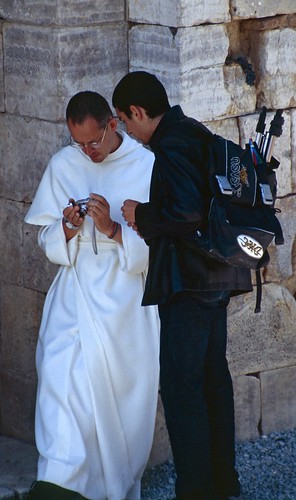 After recent experiences at the airport of queues from hell. The average on the American and British Airways desks was well over an hour. So, imagine my surprise of the queue at the AlItalia desk. One person. So, being there three hours early, plenty of time for retail therapy. I picked up a couple of books, a Bill Bryson one, and one by a Brit called Tom Sharpe. So, Bill Bryson and I whiled the hours away until the flight was called to board.
After recent experiences at the airport of queues from hell. The average on the American and British Airways desks was well over an hour. So, imagine my surprise of the queue at the AlItalia desk. One person. So, being there three hours early, plenty of time for retail therapy. I picked up a couple of books, a Bill Bryson one, and one by a Brit called Tom Sharpe. So, Bill Bryson and I whiled the hours away until the flight was called to board. One thing that never ceases to amaze me is the stampede in which everyone tries to get on board at the same time, and be first to sit. I had an aisle seat, so no hurry. So, carried on reading. I also knew that it was against FAA rules for a plane to fly with the luggage of someone who was not on the plane. In other words, it was going nowhere without me. Walking on the plane, I noticed the two women in front of me were on the same tour as I, and so I struck up conversation with them. There were both in their late 50’s, sisters, and both widowed within four months of each other. One, Anne, was from Leeds, where they both grew up, and the other, Denise, had moved down to Buckingham. So, we chatted throughout the flight, and marvelled at the in flight catering: One stale ham roll, and a boiled sweet. And the in-flight staff did not look happy. The reason, we found out, was that the airline had gone bust, and they were all out of a job the next day. And we were without an airline to get home in 12 days time. Still, stuck in Italy, not all bad news, is it?
There was chaos at Rome airport, as we could not find the guide, and people from the tour wandered around looking confused. Seems like we came out the wrong door from customs. So, we were directed to the coach, loaded up the bags and took our seats. Not much to tell of the trip to Tuscany, just traffic jams around Rome, clear blue skies, fields filled with olives and vines. And fields and fields of sunflowers. But, they were all gone to seed, but it did not take much imagination to see them all in bloom, in the sun. And a lot of the local art featured these sunflowers.
Tuscany started as soon as we left the autostrada, green fields, Cyprus trees, and terracotta tiled houses everywhere. And topping hills, were walled villages and towns, whilst the valleys were newly ploughed. The hillsides were filled with olive trees and vines, all full of ripe grapes, just about ready to harvest.
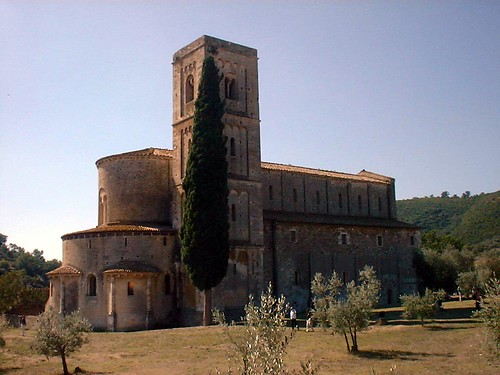 We were staying in a town called Chianciano Terme, a spar town, spit into two, and old part, walled and on a promontory, and a new part, where all the hotels were. Which is where we were, of course. The hotel was fine, and friendly. With the exception of the barmaid/tender, who was a Romanian who had been told she had to leave as the holiday season was coming to an end. With the result she was trying her best to bring everyone down to her level of sadness. She also failed to add half our drinks to our room bills, we guessed as a way of getting back at the owners.
We were staying in a town called Chianciano Terme, a spar town, spit into two, and old part, walled and on a promontory, and a new part, where all the hotels were. Which is where we were, of course. The hotel was fine, and friendly. With the exception of the barmaid/tender, who was a Romanian who had been told she had to leave as the holiday season was coming to an end. With the result she was trying her best to bring everyone down to her level of sadness. She also failed to add half our drinks to our room bills, we guessed as a way of getting back at the owners. Mealtimes were a little canteen-like. With the aim of getting us through as soon as possible, but the food was very good, always hot, and we were always offered more. Which was a difference to the supposedly better hotel on the Amalfi coast where we were to spend the second week. But, a few of decided to stay in the bar, and brave the frostiness form behind the bar. But it was hard, and she glared at any laughter of fun.
The Wednesday, a short trip was planned to two local towns, Pienza and Montepulciano. Only 14 of us decided to go on the trip, and we left at a relaxed time of half ten, in a heavy drizzle. Pienza was a small town, walled and on a hill, rebuilt by Pope Pious the second to be a utopia on earth. A palace there was modelled on one in Florence, on a piazza next to an imposing white church. The town itself was quite small, but the ramparts had imposing views across the countryside, and over the winding road leading up to it.
The 500-year-old houses held coffee shops, salami and cheese shops, along with wonderful herb shops. All giving the town a wonderful smell. I bought several bags of herbs, and headed off to record the town with my camera. They were filming an historic program for Italian TV when we were there, and there were banners and flags hanging everywhere, adding to the atmosphere of the town.
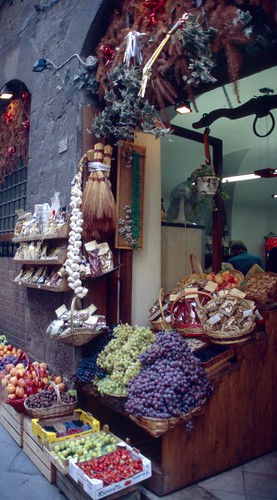 Once were back on the coach, the guide said she knew of a place, that did tastings of local salamis, cheeses and wines, and for a small price, would we like to go there? Of course we did. It was next to a wonderful church, under the town walls of Montepulciano. When I say it was next to the church, it was in fact under it, in the crypt, or next to it. And it had views over the valley, which added to the feel of the place. The food was wonderful, as so was the wine. And the speciality was a desert wine called Vino Santo. Into which, one dipped biscuits. Not as bad as it sounds, very good in fact. So good we all bought a bottle, and dipping biscuits.
Once were back on the coach, the guide said she knew of a place, that did tastings of local salamis, cheeses and wines, and for a small price, would we like to go there? Of course we did. It was next to a wonderful church, under the town walls of Montepulciano. When I say it was next to the church, it was in fact under it, in the crypt, or next to it. And it had views over the valley, which added to the feel of the place. The food was wonderful, as so was the wine. And the speciality was a desert wine called Vino Santo. Into which, one dipped biscuits. Not as bad as it sounds, very good in fact. So good we all bought a bottle, and dipping biscuits. The town itself was a large place; with a winding road leading from the town gates, and twisting it’s way up to the town piazza. Once again, the shops were of the Tuscan mix of cheese, salami, wine and art galleries. The weather was still grey, but it did not detract from the town at all. One thing I will mention here is that Italy is such a chic place, full of style. Which makes the state of Italian plumbing all the more of a surprise, and the visit to a coffee shop here a real adventure. The toilet itself was just two enamel footprints over a hole in the floor. I will draw a discreet veil over the mechanics of using this, but, if nothing else, it was an experience. Note to self; go before leaving hotel. Twice.
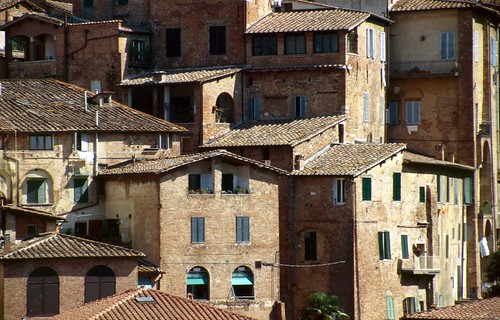 We had an uneventful trip back to the hotel, in plenty of time to get ready for the evening meal. As the atmosphere in the bar was so bad, a few of us decided to head into the town, to what else there was to do. We found a bar, which spread out onto the side of the road. And they had a karaoke going on. What struck us, was that there were very few young people there, but those that were, were sat with their families. Something that would be unheard of in England. We had a good time, people watching, and trying to guess what songs they were singing. But, what was clear, was that they were singing folk songs, in a traditional manor, or as traditional as it could be with a synthesiser and a computer.
We had an uneventful trip back to the hotel, in plenty of time to get ready for the evening meal. As the atmosphere in the bar was so bad, a few of us decided to head into the town, to what else there was to do. We found a bar, which spread out onto the side of the road. And they had a karaoke going on. What struck us, was that there were very few young people there, but those that were, were sat with their families. Something that would be unheard of in England. We had a good time, people watching, and trying to guess what songs they were singing. But, what was clear, was that they were singing folk songs, in a traditional manor, or as traditional as it could be with a synthesiser and a computer.On Saturday, we headed off to Florence. We had an early start, as to get there before the rush, which we failed to do. First stop was a place called Pizza Leonardo a Vinci, with wonderful views over the river to the city. We were lucky as the weather was wonderful, so the terracotta tiles showed up brilliantly against the azure sky. What a sight Florence was, all the wonderful renaissance buildings and churches seemingly untouched by the modern world. After a short stop for photographs, we headed on the bus into the centre of the city, to meet up with a guide.
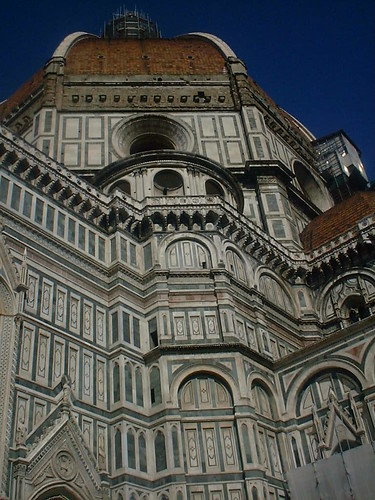 I am not one to criticise, but the guide did know her stuff, but it made for a slow tour, and with just 6 hours in the city, I was aching to head off and take pictures alone. We looked into two wonderful churches. They would have been stunning, if it had not been for the damage caused by a serious flood in 1966, which damaged many of the works of art in many of the buildings. We saw tombs for Leonardo, and Michelangelo, Goethe, and Machiavelli. All of which stunning, but the one to Galileo, which was carved with the stars. To be so close to history was really awe inspiring.
I am not one to criticise, but the guide did know her stuff, but it made for a slow tour, and with just 6 hours in the city, I was aching to head off and take pictures alone. We looked into two wonderful churches. They would have been stunning, if it had not been for the damage caused by a serious flood in 1966, which damaged many of the works of art in many of the buildings. We saw tombs for Leonardo, and Michelangelo, Goethe, and Machiavelli. All of which stunning, but the one to Galileo, which was carved with the stars. To be so close to history was really awe inspiring. 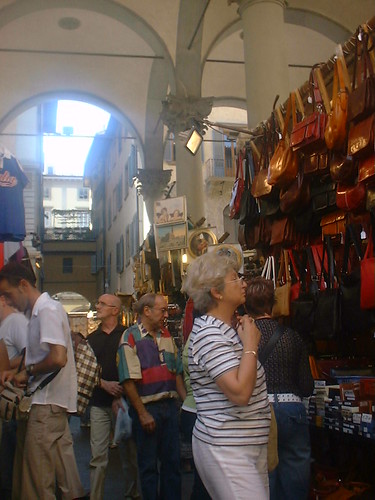 After ending up at the doma, the cathedral, we parted company with our guide at a copy of the statue of Michael. The original is in a museum, much too precious to be left outside. The area around the cathedral is renound as a haunt for pick pockets. And so elaborate precautions were needed to be made. Which, it has to say, took something of the shine away from the city.
After ending up at the doma, the cathedral, we parted company with our guide at a copy of the statue of Michael. The original is in a museum, much too precious to be left outside. The area around the cathedral is renound as a haunt for pick pockets. And so elaborate precautions were needed to be made. Which, it has to say, took something of the shine away from the city. Gangs of what were quite obviously foreigners hung around the popular places, looking for unguarded bags and wallets. In most public places, people had set up towels of cardboard boxes selling what would best be described as tat. That they sold only about four different types of goods, and the fact there were hundreds of them all over the city was disappointing. That they took up many of the best vantage points, as a photographer was annoying.
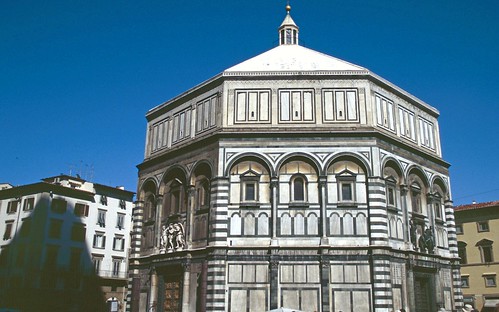 I headed off to the Ponte Vecchio, and the coolness of the river. Only to find just about every tourist had the same idea as I. The bridge is similar to the old London Bridge, in that it has houses, or rather did, and now shops. Lots of shops. And pigeons. Looking at my map, I could see there were some ornamental gardens a short walk away, and so I headed off through the throngs in the narrow streets in what I hoped was the right direction.
I headed off to the Ponte Vecchio, and the coolness of the river. Only to find just about every tourist had the same idea as I. The bridge is similar to the old London Bridge, in that it has houses, or rather did, and now shops. Lots of shops. And pigeons. Looking at my map, I could see there were some ornamental gardens a short walk away, and so I headed off through the throngs in the narrow streets in what I hoped was the right direction.The Boboli gardens go all the way up the valley side, and at was a tough walk in the heat of midday to get up there. There was a fountain, as ever. But at the top, the city had preserved an idealised Tuscan valley, with olive groves, vines and the ever-present Cyprus trees. All mixed in with terracotta-tiled villages and ruined castles. Very picturesque, and unexpected in a city.
Afterwards, after what was probably the most expensive salad I have ever had, I wandered the streets, and the street markets, people watching. At times it was a worrying place, with more gangs hanging around, apparently looking for victims. I found my way to the Church of San Lorenzo, and the Medici Chapels. I think by this time, I was getting immune to works of architectural wonder. All very wonderful, but feeling more like art galleries than places of worship, though they can be both, I guess?
It was some relief to get away from the crowds, and find a back street bar, cool with even colder beer. I know drinking whilst hot and tired was not a good idea, but I did feel better. So, it was a relief to rendezvous with the bus, and that we all made it back in time was also good. And so, we said goodbye to Florence, and I promised myself to go back someday, if only to the Uffizi Gallery to see all the wonders of renaissance art.
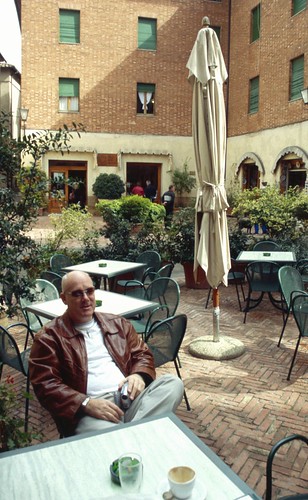 Sunday was supposed to be a quiet day; we headed off to the town of Montalcino. Another hilltop, fortified town, with imposing, if not stunning views across the Tuscan countryside. We discovered that Sundays was the day for cycle racing and vintage car runs. The result was that all the roads to a small spar we were to visit were closed and we headed off to the Monastery of Sant’Antimo. I can’t tell how old it was, but it was overshadowed by a massive Cyprus tree, which itself must have been hundreds of years old.
Sunday was supposed to be a quiet day; we headed off to the town of Montalcino. Another hilltop, fortified town, with imposing, if not stunning views across the Tuscan countryside. We discovered that Sundays was the day for cycle racing and vintage car runs. The result was that all the roads to a small spar we were to visit were closed and we headed off to the Monastery of Sant’Antimo. I can’t tell how old it was, but it was overshadowed by a massive Cyprus tree, which itself must have been hundreds of years old. Inside, through the open doors, we could hear the service, lots of Latin chanting form the monks. We were free to either go inside, or stay outside. I did the latter, and was intrigued to see a monk being shown the wonders of modern digital photography. The monastery was overshadowed by another town on a hill, with a winding road, lined with more Cyprus trees, leading up to it.
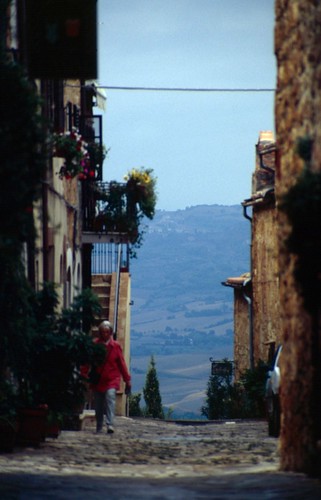 When the service, or Mass as I guess it was, was over, we boarded the bus to head off to Montalcino. As usual, the tour guide knew of a cheap place, and you know the rest. So once there, we found that the cycle race ended there as well. We fought our way through the crowds of cyclists sweating in their tight fitting Lycra to the taverna she knew. Around the town, they grow a special wine, where they only allow the grapes on the lower limbs of the vines to grow. Thus the grapes are sweeter than usual, and the wine stronger. It is called Brunello, and is wonderful; needless to say, we sought out a wine shop as soon as we could. The views from this town were really special, and I think I did probably take a few too many pictures.
When the service, or Mass as I guess it was, was over, we boarded the bus to head off to Montalcino. As usual, the tour guide knew of a cheap place, and you know the rest. So once there, we found that the cycle race ended there as well. We fought our way through the crowds of cyclists sweating in their tight fitting Lycra to the taverna she knew. Around the town, they grow a special wine, where they only allow the grapes on the lower limbs of the vines to grow. Thus the grapes are sweeter than usual, and the wine stronger. It is called Brunello, and is wonderful; needless to say, we sought out a wine shop as soon as we could. The views from this town were really special, and I think I did probably take a few too many pictures. It was good to wander away from the tourist areas, to where the houses are, and see how they live in a town with such narrow streets. Lunch as ever, was wonderful, a salad, a pasta dish. Very light, but tasty. I did a bit of exploring on my own, and to my surprise the town was bigger than I thought, and I managed to be late for the bus back. It was not to be the last time I would mess up a trip back to the hotel. But, more of that later. On my walk, I did find a nice wine shop, and treated myself to a bottle of the Brunello wine.
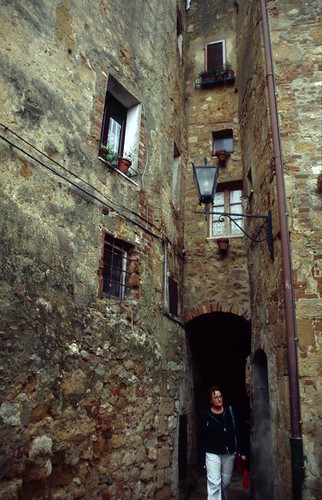 Our last full day in Tuscany, was a trip to Sienna. A trip of just over an hour, once again through the Tuscan countryside, all ploughed fields, vines and olive groves, with above us, hilltop towns looking down. Words cannot do justice to this place, and I know mine do not. Anyway, Sienna is another Tuscan city, hundreds of years old, with the centre apparently unchanged sine the days of Da Vinci. Once again, a guide met us at the bus, and took us through the historic old town, describing to us the buildings and the stories behind them. At the centre of Sienna is Piazza Del Campo, a huge piazza, around which, twice a year, horse races take place, with the honour of boroughs of the city at stake.
Our last full day in Tuscany, was a trip to Sienna. A trip of just over an hour, once again through the Tuscan countryside, all ploughed fields, vines and olive groves, with above us, hilltop towns looking down. Words cannot do justice to this place, and I know mine do not. Anyway, Sienna is another Tuscan city, hundreds of years old, with the centre apparently unchanged sine the days of Da Vinci. Once again, a guide met us at the bus, and took us through the historic old town, describing to us the buildings and the stories behind them. At the centre of Sienna is Piazza Del Campo, a huge piazza, around which, twice a year, horse races take place, with the honour of boroughs of the city at stake. Around the piazza, are many tall houses and palaces. In between, are narrow alleyways, linking with the narrow streets behind. We again visited churches. And for the cathedral, I was all churched out, and being thirsty, retired to a café for a double espresso. As it turned out, I missed the wonder of renaissance gothic architecture, inside was all black and white marble, without doubt, I was told, the best church we visited. Or rather THEY visited. Oh well, I went exploring again, and took many photos.
I found a quiet taverna to have lunch, and had a nice meal of gnocchi and onion soup, and more local wine. It was crowded, but not as bad as Florence. But, by about three, I had had enough of wandering, and went to the meeting place, and people watched for an hour. People of apparently every nation on Earth getting off buses, meeting up with guides, and the now ubiquitous digital camera snapping away.
The last night at the hotel in Tuscany was a quiet affair. Most of the other opting for an early night, as we had an early start next day. To our surprise, the bar bill was much less than we thought; we put it down to the moody bar tender getting back at the owners.
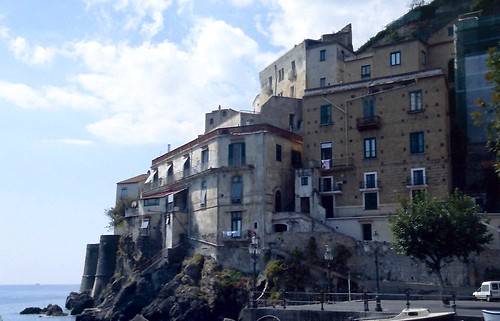 The trip to the Amalfi coast was a seven-hour bus drive, and we were not looking forward to it. But, in the end, with frequent stops for coffee it whizzed by. We went past places that had been fiercely fought over during the war, especial Monte Casino, which we bombed to the ground. But has now been re-built. It overlooks the valley, and I guess you could se the sea from its terraces. As we neared Naples, the dark shape of Vesuvius loomed large. Naples is built around the foot of the volcano, and up it’s slopes.
The trip to the Amalfi coast was a seven-hour bus drive, and we were not looking forward to it. But, in the end, with frequent stops for coffee it whizzed by. We went past places that had been fiercely fought over during the war, especial Monte Casino, which we bombed to the ground. But has now been re-built. It overlooks the valley, and I guess you could se the sea from its terraces. As we neared Naples, the dark shape of Vesuvius loomed large. Naples is built around the foot of the volcano, and up it’s slopes. The thought of an eruption fills me with dread. One suburb of Naples is the most densely populated part of Europe. And it is that part which surrounds Herculaneum, which of course was covered along with Pompeii in AD 79. If it can happen once, it can happen again.
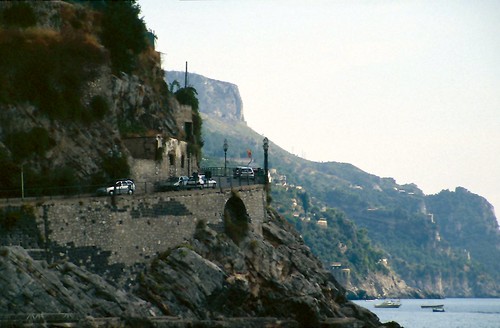 We left Naples, turned off the Autostrada, and headed off into the hills. We tuned off the main road, and the road soon became steep, with many sharp turns and hairpin bends. All along the increasingly high cliff, small villages clinged on to the earth. And over our shoulders, the bay of Naples, along with the volcano stretched out into the haze of the horizon. After about 45 minutes, we entered a short tunnel, as the road gave up trying to get over the summit of the hill.
We left Naples, turned off the Autostrada, and headed off into the hills. We tuned off the main road, and the road soon became steep, with many sharp turns and hairpin bends. All along the increasingly high cliff, small villages clinged on to the earth. And over our shoulders, the bay of Naples, along with the volcano stretched out into the haze of the horizon. After about 45 minutes, we entered a short tunnel, as the road gave up trying to get over the summit of the hill. We came out in a typical Italian village, small houses, all with blinds firmly down, a few children on the way home from school, a white church. And then, the most amazing few came into sight. We were perched at the top of a cliff, some two thousand feet high, and it fell away very steeply to the Mediterranean below. Scattered along the cliff, were small villages, along with the white churches. And the knowledge that we were going to have to get down the cliff on what constituted the road. At one point, we counted 12 levels of the road below us. Churches that were ten minutes ago, were hundreds of feet below us, appeared around the hairpin bends. Only to be towering above us a few minutes later.
Sitting at the window seat, to see the sea below, and only a thin metal fence separating the bus from tumbling down the cliff was sobering. The driver was brilliant, and dealt with oncoming vehicles by stopping the bus right next to the railings. It took the best part of an hour to negotiate the road down to sea level. And unfortunately, there were no parking places big enough for a bus, so I have no pictures of that trip. But it will live in my memory for a long time. One woman was so scared; she did not leave the town with the hotel for the whole week. And tried very hard to find another way to get to the airport when we came to leave.
As we drove along the main Amalfi coast road, we realised it was no wider than the one we came down on. So, progress was very slow at time. But, after passing through the main town of the coastline, Amalfi itself, we came to our base for the next week, Minori. Minori is a small fishing village, with a harbour, a few shops, mainly for locals, a large church, and a small square with a couple of bars. The town is built into a cleft in the cliff, with narrow streets. Too narrow for busses, so we stopped on the main road, and walked up to our hotel.
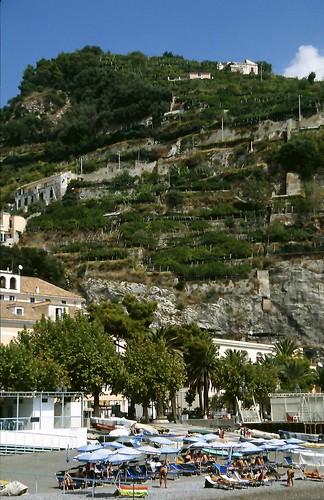 The hotel was very nice, all staff in white coats and ties, and nothing was too much trouble. They even brought our cases up from the harbour, and delivered them right up to our rooms, something I don’t think would have happened in England. My room was much bigger than the one in Tuscany. In that one I could have a shower, shave, clean my teeth, and use the bidet and toilet, without moving. My room here, we big, though strangely, the bathroom was bigger than the bedroom. But, it was good, and there was a mini bar, with the typical overpriced stuff.
The hotel was very nice, all staff in white coats and ties, and nothing was too much trouble. They even brought our cases up from the harbour, and delivered them right up to our rooms, something I don’t think would have happened in England. My room was much bigger than the one in Tuscany. In that one I could have a shower, shave, clean my teeth, and use the bidet and toilet, without moving. My room here, we big, though strangely, the bathroom was bigger than the bedroom. But, it was good, and there was a mini bar, with the typical overpriced stuff. 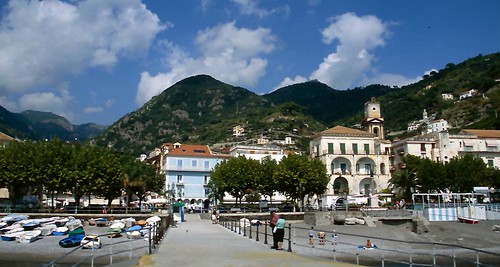 That night, we met in the bar, and had a welcome drink provided by the hotel, and once again divided into our little cliques to sit at our various tables. I sat with a couple from Swindon, John and his wife, the two sisters, and a lone lady called Vicky, who was 80, and on her own, having recovered from a minor stroke. John and I had very similar sense of humour, which spelt trouble for others, as we could be found doubled up in laughter at someone else’s slip of the tongue. There was a separate wine waiter, and John and I decided to take turns in buying a bottle of wine, one each day. Which worked out quite well.
That night, we met in the bar, and had a welcome drink provided by the hotel, and once again divided into our little cliques to sit at our various tables. I sat with a couple from Swindon, John and his wife, the two sisters, and a lone lady called Vicky, who was 80, and on her own, having recovered from a minor stroke. John and I had very similar sense of humour, which spelt trouble for others, as we could be found doubled up in laughter at someone else’s slip of the tongue. There was a separate wine waiter, and John and I decided to take turns in buying a bottle of wine, one each day. Which worked out quite well.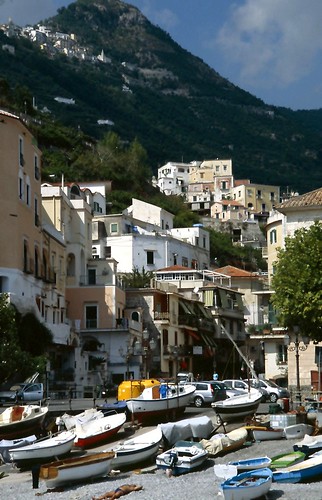 The next day was a gentle one, beginning with a guided walking tour around the town. We went to a coffee shop, to try the locally made pastries, and sample the traditional espresso. From there we went to a ceramic workshop, majolica is made all along the coast, and is decorated with fruits.
The next day was a gentle one, beginning with a guided walking tour around the town. We went to a coffee shop, to try the locally made pastries, and sample the traditional espresso. From there we went to a ceramic workshop, majolica is made all along the coast, and is decorated with fruits. A popular figure was that of Bacchus, the Roman God of wine and feasting, we were to see his grinning face all along the coast. Finally, we went to a pasta shop, where pasta is made by hand. And there, as everywhere else, they had their own local shaped pasta, which was made by wrapping the pasta around a wire, and rolling the pasta along the work surface. It was very expensive, as each piece was hand made, and could not be machine made. The shops and workshops were found along narrow alleyways that criss-crossed the town. And at the end of the alleys, the sides of the cliffs could be seen reaching to the heavens.
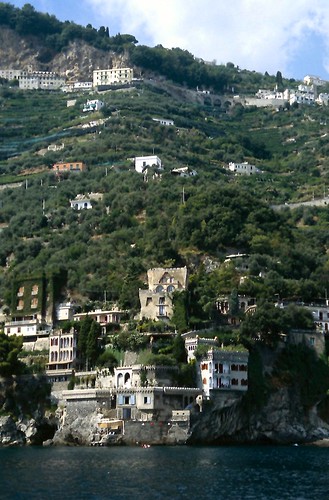 That afternoon, we met at the harbour for the afternoon’s excursion, a boat trip to Positano. Positano is a town about 15 miles along the coast to Naples, and is built on a steep cliff. All the houses and shops are either pastel coloured of whitewashed, and linked by steep alleyways.
That afternoon, we met at the harbour for the afternoon’s excursion, a boat trip to Positano. Positano is a town about 15 miles along the coast to Naples, and is built on a steep cliff. All the houses and shops are either pastel coloured of whitewashed, and linked by steep alleyways.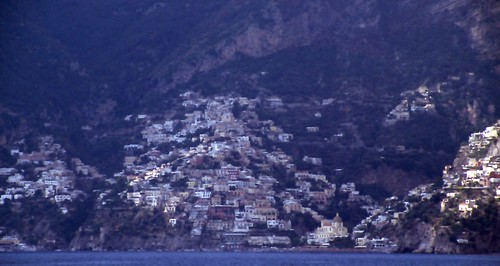 We agreed to split up for lunch, my group to the bar we had visited the night before for salad and iced tea, which had introduced the group to. Just before one, we met up on the quay for the arrival of our boat to take us to Positano. It was a converted fishing boat, with seating around the sides. And the guide gave us a commentary all along the coast as to what interesting places we could see. It turned out to be either 5 star hotels whose prices we could not dream of affording, or the summer homes of the rich and famous.
We agreed to split up for lunch, my group to the bar we had visited the night before for salad and iced tea, which had introduced the group to. Just before one, we met up on the quay for the arrival of our boat to take us to Positano. It was a converted fishing boat, with seating around the sides. And the guide gave us a commentary all along the coast as to what interesting places we could see. It turned out to be either 5 star hotels whose prices we could not dream of affording, or the summer homes of the rich and famous. At the midway point, we stopped off at the azure grotto. The grotto is a cave, with an underwater entrance, which when the sun shines has the most wonderful colour. It is reached from a small jetty, and along a narrow passageway, to a small quay, where small rowing boats were waiting to take us into the cave. It was wonderful, and even better, as we returned to the quay, the rower splashed with his oar, and the surface sparkled as if suddenly covered with jewels. All an optical effect, but wonderful none the less.
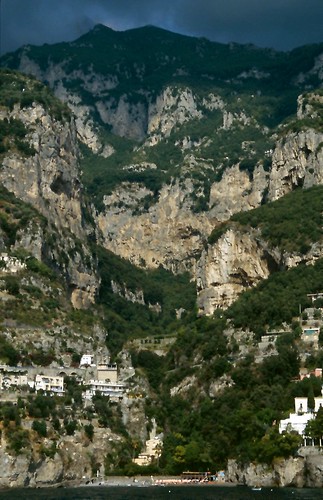 Positano is he most famous place on the Amalfi coast, it was crowded, until we learned what crowds really were later in the week. Our group split up, with most going with the tour guide who promised them the best patisserie on the Naples Rivera. In the end, we all ended up there, sampling the homemade apricot tea and ice cram. There were narrow passageways, all with shops built into the walls. And the clothes shop had their wares hanging on the side of the walls outside, forcing passing people to force their way through the dresses and t-shirts.
Positano is he most famous place on the Amalfi coast, it was crowded, until we learned what crowds really were later in the week. Our group split up, with most going with the tour guide who promised them the best patisserie on the Naples Rivera. In the end, we all ended up there, sampling the homemade apricot tea and ice cram. There were narrow passageways, all with shops built into the walls. And the clothes shop had their wares hanging on the side of the walls outside, forcing passing people to force their way through the dresses and t-shirts. It reminded me of The Lion, The Witch and the Wardrobe, expecting to come out in an arctic wood at some point. There is noting quite like sitting in the shade of an Italian coffee shop, eating Pistachio Ice Cream, and watching the world go by. So good in fact, we soon had coffee to go with the ice cream too. The journey back was wonderful, as the cliffs caught the setting sun, and the air was full of the smell of burning leaves as the farmers burnt that days rubbish from the groves and vineyards. As we headed away from Positano, Capri was just viable as we looked into the setting sun, silhouetted against the bright sky. It looked wonderful, and we would be going there at the weekend.
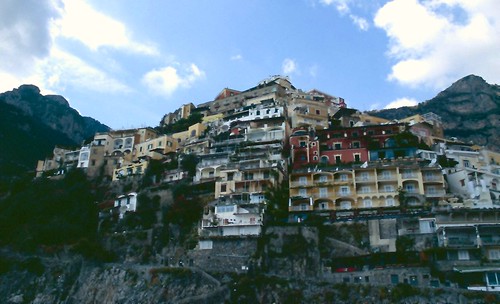 Next day was an extended half-day trip to Paestum. We were wondering what the difference between a half-day, extended half day and a full day trip. In the end it seemed to be about half an hour each. Paestum is away from the Amalfi coast, beyond Solerno. The drive along the coast was spectacular to say the least. The road was never more than two cars width, and we were in a big bus. So, other traffic had to get out the way, unless two busses met, in which case it was interesting. At times the road was level with the sea, and others it climbed hundreds of feet above the ocean. We passed through small fishing villages, around gorges cut into the face of the cliffs. The last town before Solerno made ceramics as its speciality. And all the churches along the coast had tiled domes that caught the sun. All the shops on the main street had tiled fronts, depicting what could be bought inside.
Next day was an extended half-day trip to Paestum. We were wondering what the difference between a half-day, extended half day and a full day trip. In the end it seemed to be about half an hour each. Paestum is away from the Amalfi coast, beyond Solerno. The drive along the coast was spectacular to say the least. The road was never more than two cars width, and we were in a big bus. So, other traffic had to get out the way, unless two busses met, in which case it was interesting. At times the road was level with the sea, and others it climbed hundreds of feet above the ocean. We passed through small fishing villages, around gorges cut into the face of the cliffs. The last town before Solerno made ceramics as its speciality. And all the churches along the coast had tiled domes that caught the sun. All the shops on the main street had tiled fronts, depicting what could be bought inside. 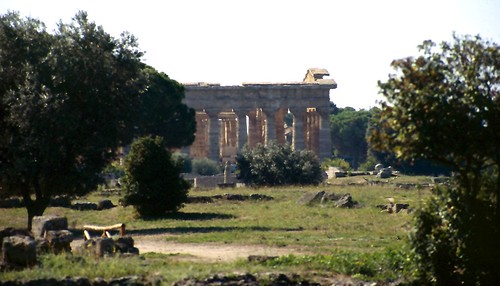 Paestum was built on the plains south of Solerno, between what were swamps in antiquity. As the towns got poorer as went slowly south, the beachside shops slowly falling into decay. We turned inland, over lazy rivers meandering through reed banks. We came upon massive walls. This was Paestum. Inside was a Roman town, but even better, three classic Greek temples from half a millennia before Christ.
Paestum was built on the plains south of Solerno, between what were swamps in antiquity. As the towns got poorer as went slowly south, the beachside shops slowly falling into decay. We turned inland, over lazy rivers meandering through reed banks. We came upon massive walls. This was Paestum. Inside was a Roman town, but even better, three classic Greek temples from half a millennia before Christ. The temples towered over what was left of the town, and wonderfully, they we in remarkable condition. Two of the temples were next to each other, and even the inner sanctum of one was still there. All that were missing were the roofs. Nearby, was a museum, were the marble facing was still preserved. It seemed that the Romans left previous civilisation’s religious buildings along, even incorporating them into their own beliefs. Christian church builders however, cannibalised anything they could get their hands on to build the early churches.
Paestum survived because it was in the middle of a swap, and remained undiscovered for over 1500 years. What was even more wonderful about it, was that it is relatively unknown, and we had the site almost to ourselves. Once we had toured the site and museum, we had lunch in a nearby taverna, more local soft cheese and tomato salad.
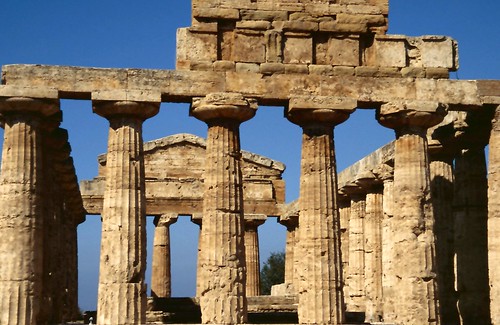 It had been a hot day, so I thought I would treat myself to a proper Italian haircut. There was a barber on the walk up to the hotel from the harbour, so I thought I would give it a try. Good luck was that he was open, and no one was waiting. We got on really well, I spoke no Italian, and unlike everyone else in Italy, he spoke no English. He guessed I wanted a haircut, and soon he was cutting away, and hair was flying off in all directions. He finished, and I motioned to get up, he said to wait. And snipped away at my eyebrows. Once again I went to get up, and he motioned to stay sitting. What happened next was not what I expected, he changed the grip on the scissors, and put them up my nose, a quick snip to get rid of any hairs, up the other nostril, and snip. And, it was all over. Oh how I laughed, and so did my friends in the bar when I told them.
It had been a hot day, so I thought I would treat myself to a proper Italian haircut. There was a barber on the walk up to the hotel from the harbour, so I thought I would give it a try. Good luck was that he was open, and no one was waiting. We got on really well, I spoke no Italian, and unlike everyone else in Italy, he spoke no English. He guessed I wanted a haircut, and soon he was cutting away, and hair was flying off in all directions. He finished, and I motioned to get up, he said to wait. And snipped away at my eyebrows. Once again I went to get up, and he motioned to stay sitting. What happened next was not what I expected, he changed the grip on the scissors, and put them up my nose, a quick snip to get rid of any hairs, up the other nostril, and snip. And, it was all over. Oh how I laughed, and so did my friends in the bar when I told them.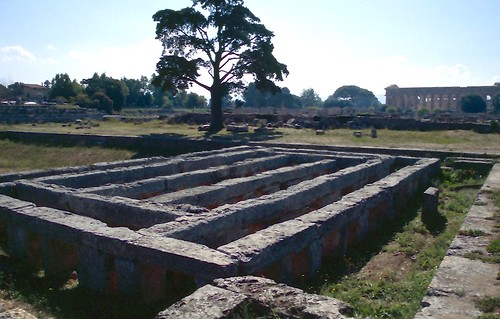 Friday was a trip to Herculaneum, famous of course, for being one of the other towns to be destroyed by the ad 79 eruption of Vesuvius. The entrance to the site is among the busiest part of Naples, with the clouded shadow of the volcano towering above us. The locals dislike the visiting tourists, as the tour busses whisk to visitors to the site, and away again after the visit. So, almost no tourist money is spent in the area. We were warned of pickpockets, and worse, so to keep together on the walk to the pick up place for the bus.
Friday was a trip to Herculaneum, famous of course, for being one of the other towns to be destroyed by the ad 79 eruption of Vesuvius. The entrance to the site is among the busiest part of Naples, with the clouded shadow of the volcano towering above us. The locals dislike the visiting tourists, as the tour busses whisk to visitors to the site, and away again after the visit. So, almost no tourist money is spent in the area. We were warned of pickpockets, and worse, so to keep together on the walk to the pick up place for the bus. In reality, we saw a slice of normal Italian life, shops, garages, workshops that would have been great to look around, and maybe snap pictures of. But, it was not to be. Traffic was doubly bad, as the local government had organised a protest march of two aid workers captured in Iraq, so thousands of schoolchildren with banners brought the city to a standstill. By the end of the week, the workers would be freed, at least some good news for the city.
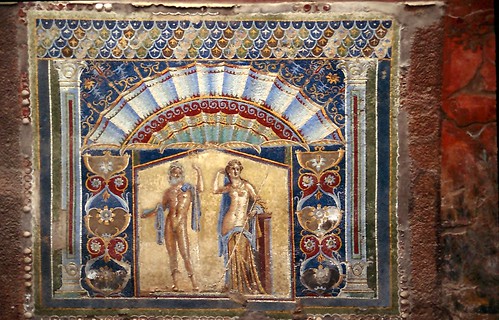 We approach the site along a shallow sloping ramp; with views overlooking what has been explored so far. So we had views over the whole site, which is not very big, about the same size a 8 city blocks, as the rest is under the city of Naples. Straight narrow streets led to what was once the waterfront, but is now 200 feet above sea level, and over a mile from the current shoreline. Once again, a guide was waiting for us, and he told us a little about what is know of the town. It was a much smaller place than Pompeii, but still much has been learned from the finds there.
We approach the site along a shallow sloping ramp; with views overlooking what has been explored so far. So we had views over the whole site, which is not very big, about the same size a 8 city blocks, as the rest is under the city of Naples. Straight narrow streets led to what was once the waterfront, but is now 200 feet above sea level, and over a mile from the current shoreline. Once again, a guide was waiting for us, and he told us a little about what is know of the town. It was a much smaller place than Pompeii, but still much has been learned from the finds there. Most wonderful, was that due to the way the town was covered, a lot of organic material survived, as well as hundreds of mosaics. The mosaics looked as if they were laid yesterday, and it was odd to be able to walk over them. One villa had wonderful mosaics on the wall, with full perspective views of building. Such art would not be done again in mainland Europe until the Renaissance. Due to the fact, so much ash over 30 metres high. And above that, sides of blocks of flats towered even higher. Organic material had survived, it was possible to tell what plants had grown in the gardens of the villas, and new plants had been planted, making the impression that the owners of the villas had just left. A very odd feeling indeed.
At the side of the site, walls of and above it all, Vesuvius, green and serene. The highlight of the tour, was a villa of a rich merchant, and hidden away at the back, was the most wonderful mosaic on the wall, and a tiled alter to the local Gods. All looking like they were brand new.
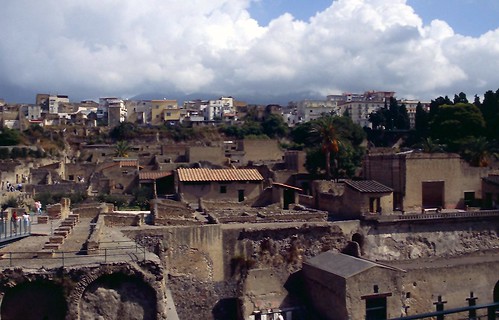 Saturday should have been a trip to the Island of Capri, but bad weather with strong winds had kept all boats in harbour Friday and Saturday, so the final trip to Pompeii was brought forward a day, and Capri would be on Sunday. So, once more we set out on the bus along the twisty coast road to Solerno. By now we were so used to passing other coaches and lorries, that we hardly paid any attention. It turns out that for most Italian bus drivers, a trip along this road is the last part of their driving test, as the logic goes, if you can drive along there, you can drive on any road. Stories, whether true or not, abound of inexperienced drivers abandoning their vehicles along with passengers, as their nerves are frayed.
Saturday should have been a trip to the Island of Capri, but bad weather with strong winds had kept all boats in harbour Friday and Saturday, so the final trip to Pompeii was brought forward a day, and Capri would be on Sunday. So, once more we set out on the bus along the twisty coast road to Solerno. By now we were so used to passing other coaches and lorries, that we hardly paid any attention. It turns out that for most Italian bus drivers, a trip along this road is the last part of their driving test, as the logic goes, if you can drive along there, you can drive on any road. Stories, whether true or not, abound of inexperienced drivers abandoning their vehicles along with passengers, as their nerves are frayed. Our guide told us of a driver having a mental breakdown whilst driving along it a couple of years ago. He was only able to continue after some wine, and taking most of his clothes off. Well, nothing like that happened to us, though some of the German coach drivers were looking none to happy, and had to be told how two busses could really pass each other on a hairpin bend, and yes, that does mean the end of your bus will be hanging over a 500 foot cliff, but yes, it is safe.
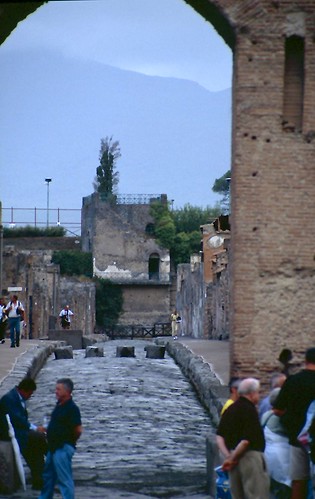 Pompeii is quite near to Herculaneum, and it was pointed out by some of the more tired members of our party that maybe we could have done both trips in the same day. Although Vicky was so tired after the climb back up from the site yesterday, she barely made it back to the bus. We were assured that Pompeii is much flatter than Herculaneum, so that should not be a problem. Although there was a quite steep walk to the entrance, we did not have to exit the site that way. By the time we reached the site, it was raining, and the climb that was mentioned was indeed steep. And worse than that, up stone steps without non-slip mats, or handrails to grip onto. So, we made our way slowly up the slope, through the town gates, and into the city itself.
Pompeii is quite near to Herculaneum, and it was pointed out by some of the more tired members of our party that maybe we could have done both trips in the same day. Although Vicky was so tired after the climb back up from the site yesterday, she barely made it back to the bus. We were assured that Pompeii is much flatter than Herculaneum, so that should not be a problem. Although there was a quite steep walk to the entrance, we did not have to exit the site that way. By the time we reached the site, it was raining, and the climb that was mentioned was indeed steep. And worse than that, up stone steps without non-slip mats, or handrails to grip onto. So, we made our way slowly up the slope, through the town gates, and into the city itself. Pompeii has been excavated completely, and stretches for miles in all directions. It is also the most popular tourist site in Southern Italy, and most people go there at some point of their stay. We were told that it was the quietest our guides had ever seen it. But still, there were times when there were people jams, and it was impossible to gain entry to buildings. Most people travel around as a group with a guides, and there are places that just HAVE to be visited. I eventually left our group after waiting outside what used to be a brothel, as there were tow groups waiting to get in at the same time. Sorry, is it just me, but queuing up to see 2000 year old dirty pictures did not seem worth it.
So, I headed off to quieter places in the site. And I found myself at a pair of theatres, and I had them just about to myself. As I sat in the upper row of seats, behind me, still shrouded in clouds was the ever-present shape of Vesuvius. I wish I could sound more enthusiastic about Pompeii, but the crowds meant that my memories are a little soured. The city fathers had a clever idea. All Roman carts had standard axle widths. But the streets in Pompeii had stepping stones to allow people to cross the streets. But they were positioned in such a way so that standard carts could not get passed. So all visiting merchants had to hire a local cart to deliver their goods.
The stepping-stones were necessary as the street were used as sewers and full of animal dung. It was interesting to note, that although Romans were famous for their straight road, the road to the brothel was in fact curved, so that the great and the good would not be seen entering from the main street. When I met up with the others from the party, I found out that they had been to the Amphitheatre, and impressive it was to, by all accounts.
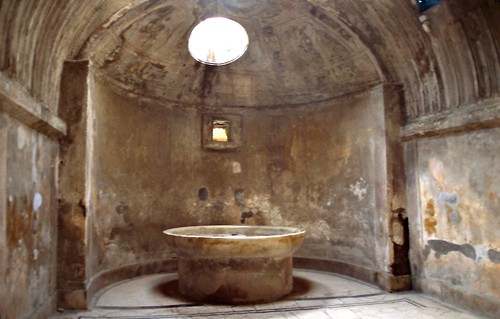 After we left Pompeii, we took a short bus ride to a local restaurant that our guide knew, and for a reasonable price, etc. So, we sat down to a pleasant light meal of, my first Italian pizza. Was it better than Domino’s or Pizza Hut? Well, it was made fresh, and the cheese was better, I guess.
After we left Pompeii, we took a short bus ride to a local restaurant that our guide knew, and for a reasonable price, etc. So, we sat down to a pleasant light meal of, my first Italian pizza. Was it better than Domino’s or Pizza Hut? Well, it was made fresh, and the cheese was better, I guess. 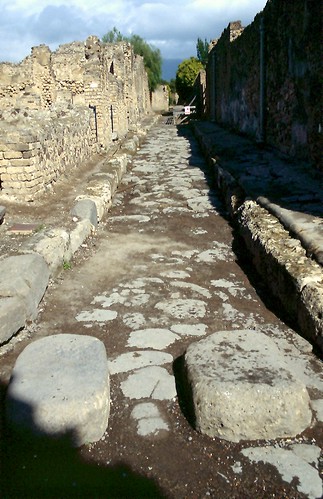 In the afternoon, we were to travel the other part of the Amalfi Coast Road, from Sorrento all the way to Amalfi and ten to where our hotel was in Minori. We were to have a stop in Sorrento as well, with chance to have a wander about, and do some shopping. Sorrento is situated on a peninsular at the southern end of the Bay of Naples, with stunning views across it. And as luck would have it, the sun came out, and it was pleasantly warm too. Sorrento is a fairly large town, and is a popular destination for English tourists.
In the afternoon, we were to travel the other part of the Amalfi Coast Road, from Sorrento all the way to Amalfi and ten to where our hotel was in Minori. We were to have a stop in Sorrento as well, with chance to have a wander about, and do some shopping. Sorrento is situated on a peninsular at the southern end of the Bay of Naples, with stunning views across it. And as luck would have it, the sun came out, and it was pleasantly warm too. Sorrento is a fairly large town, and is a popular destination for English tourists. So, there was the usual scattering of English Pubs, and bars that did English Food, with brown sauce! After visiting so many out of the way places, and out of the package tour world, it was a shock. People were wandering around in vests, and had kin the colour of boiled lobster. However, the streets were narrow, but the shops were the usual tourist traps, selling the usual tat. So, I struck out to find a good view to photograph. I walked passed the Foreigners’ Club, where you could get a ‘proper’ cup of tea, and the usual English food. Quite why people go to a culinary rich country and want to eat fish fingers and baked beans is any ones guess. So, after passing the Foreigners Club, I continued down a curved road, until I saw what I had come looking for, a view to die for.
Below me, was the harbour, with ferries either docking or just leaving, and a stream of busses carrying the tourists up the steep hill to the town. And beyond the harbour, the Bay of Naples, with Naples itself some 10 miles distant. And above Naples, Vesuvius, at last, out from it’s shroud of clouds, looking for all the world as though it was turfed all the way to the crater. It was not the middle of the afternoon, and it was quite warm. So, it was good to have the breeze coming in from the bay. Away to the left, was and the island of Capri, looking small and very hilly.
There was just enough time to find a nice café for an espresso and a glass of Sambuca, an aniseed flavoured liqueur that is very popular. And when if in Rome? I met up with Sue and Denise, who were now firm fans of iced tea. The drive back to the hotel was spectacular. Once again the road dipped and dived around the headlands of the Amalfi coast, twisted and turned along narrow gullies. We were able to stop at a parking area overlooking Positano. The views were breathtaking. There are times when words are not enough, and this was one of those times.
We all leaned on the railings and just looked. There was a vegetable stall there as well, and we all stocked up on herbs and spices again, I was beginning to get very concerned that there was no way that all the wonderful things I bought was ever going to fit in my suitcase. We arrived back in Minori just as the sun was setting; the fairy lights had come on along the promenade. So, a couple of us stopped off at our favourite bar for a fortifying coffee and more Sambuca. That night, the menu in the hotel was not very inviting, so most of us decided to try a taverna a short way from the hotel. We had a wonderful meal, and the owners made us very welcome, giving us a bottle of the two liqueurs made in the town to finish the meal with. Much better than the fish they had at the hotel, apparently.
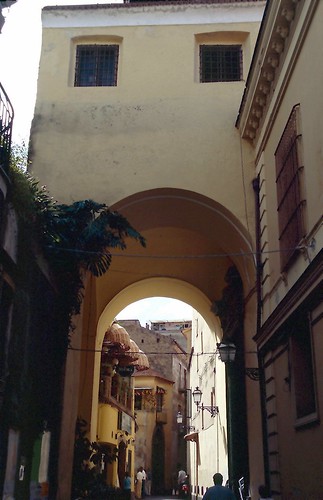
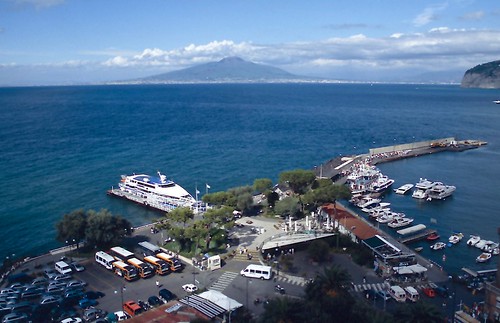 We had to be up early to get the boat to Capri. So, we met up, bleary eyed at breakfast. And then made our way to the quay. I was excited to be going to Capri, even it’s name sounded so glamorous. And, one of my favourite people, Spike Milligan had visited it during the war, finding it a delightful rural island, with quaint towns and chic cafes where it was possible to watch the world pass by. The world dressed up in their very best clothes of course. So, I was looking forward to the trip, a lot.
We had to be up early to get the boat to Capri. So, we met up, bleary eyed at breakfast. And then made our way to the quay. I was excited to be going to Capri, even it’s name sounded so glamorous. And, one of my favourite people, Spike Milligan had visited it during the war, finding it a delightful rural island, with quaint towns and chic cafes where it was possible to watch the world pass by. The world dressed up in their very best clothes of course. So, I was looking forward to the trip, a lot. As we once again made our way along the coast, the island came into view, and soon it was towering over us. Sheer cliffs surround the island, apart from two places where it was possible to build a harbour. As I said before, visiting Capri had been impossible the past two days, and being a Sunday, it seemed that all of Naples, and all tourists had the same idea of going to Capri. To call the scenes on the harbour side chaos would be a gross understatement. Every five minutes another ferry would deposit hundreds of visitors, and the supply of mini busses were over-stretched. Mini busses have to be used, as the roads on the island are even narrower than those on the coast road. There seems to be no limits on how many people can visit the island on any day, so more and more people poured onto the island.
Capri itself is small. About 10 square miles, and rises to over 2300 feet tall. There are three towns on the island, all of them geared to tourists and their apparent desire to buy even more tat. But being Capri, it was very over priced tat. The first town we visited was Ana Capri, built on a hill, narrow streets, full of touristy shops, and FULL of people. We were taken to a place the guide recommended, as always. And we had a lovely stone cold meal of what they decided to give us. And then charged us double what it would have cost on the mainland. The one saving grace that the town had is stunning views. Along from the main square, along the narrow street with its tourist shops, you come to a lookout.
A sheer drop of over 1500 feet, overlooking the main harbour, across to the Sorrento peninsular, and across the bay to Naples and the volcano. But as the weather was so bad, a steady rain was falling, the volcano was almost obscured, and we could see the sheets of rain from the next rain cloud coming towards us. It made for a dramatic picture, though.
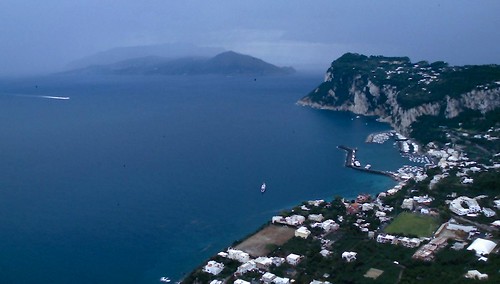 By this time, the guide who quite clearly thought he was Sherpa Tensing or something, was hurrying us along at a quick pace, which was quite unsuitable for some of the party. I said to John that I was fed up, and the crowds and the prices on the island were really too much. He suggested we walk off, as he knew the place having been there before. So, this is what we did. We headed down to the spectatular views from a garden overlooking some wave-shaped rocks with caves below. In-between was the house where Gracie Fields had lived, it is now a kind of upmarket B&B.
By this time, the guide who quite clearly thought he was Sherpa Tensing or something, was hurrying us along at a quick pace, which was quite unsuitable for some of the party. I said to John that I was fed up, and the crowds and the prices on the island were really too much. He suggested we walk off, as he knew the place having been there before. So, this is what we did. We headed down to the spectatular views from a garden overlooking some wave-shaped rocks with caves below. In-between was the house where Gracie Fields had lived, it is now a kind of upmarket B&B. We walked further up to a perfumery, where I bough fragrant soaps for people back home. Seems like Capri soap is world famous; not by me. We wandered around some more, and bought a frighteningly expensive ice cream, before deciding to head back on the bus to the harbour. We were booked on the five o’clock ferry, and warned not to be late. We squeezed on a mini bus, and the journey back down was not as scary, as my window looked to the cliff wall, not the sheer drop.
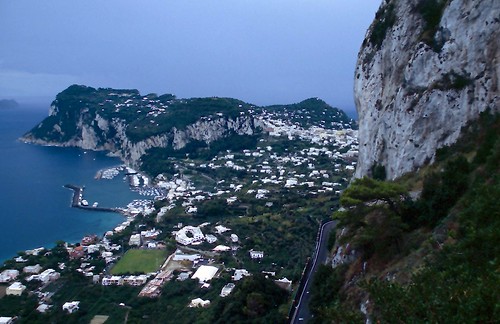 We had an half hour wait before departure, and one couple from our party had decided to take the funicular train down, only to leave it late, and made the ferry just as the ramp was being raised. The ferry was crowded, and we stood where we could, I found myself alone, which was ok. We had gotten on the boat at the rear of the boat, and as we pulled into Amalfi, I awaited to boat to swing round so we could get off. After a few minutes the engine roared back into life, and we swept out into the bay. There must have been another exit off the boat, and I had no idea where to boat would stop next.
We had an half hour wait before departure, and one couple from our party had decided to take the funicular train down, only to leave it late, and made the ferry just as the ramp was being raised. The ferry was crowded, and we stood where we could, I found myself alone, which was ok. We had gotten on the boat at the rear of the boat, and as we pulled into Amalfi, I awaited to boat to swing round so we could get off. After a few minutes the engine roared back into life, and we swept out into the bay. There must have been another exit off the boat, and I had no idea where to boat would stop next.As luck would have it, the next stop was Minori, and I made sure I got off there. Waiting on the quay was someone from the party who had chosen not to go on the trip; I asked had he seen any others off the trip; he said no. I rushed back to the hotel and got the number of the guide so I could call her and let her know I had made it back to the hotel. She already knew that the boat stopped in our town, so was not worried. I sat in the lobby to apologise to the others for messing up, only to have to wait for over an hour; the coast road was blocked by an accident, and they all thought that I had made the right decision, although it was an accident. I also wanted to say sorry to our guide to let her know that it was an accident, and not done to upset her, as I had wandered off on my own on other occasions.
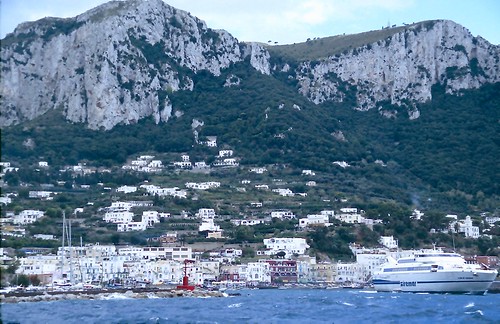 That night the smell from the kitchen was awful, boiled fish, which was just horrible. I felt ill, and Jan had to rush to the bathroom. When asked if we wanted the fish, which was a speciality, we declined, and they brought us meat cutlets, which people from other tables looked on with envy. I hate the smell of boiled fish, associating it with what mum used to cook for the cat when I was a child.
That night the smell from the kitchen was awful, boiled fish, which was just horrible. I felt ill, and Jan had to rush to the bathroom. When asked if we wanted the fish, which was a speciality, we declined, and they brought us meat cutlets, which people from other tables looked on with envy. I hate the smell of boiled fish, associating it with what mum used to cook for the cat when I was a child.On our final day, our usual party decided to walk to Majori, which was a short walk away; although a walk along the coast road, which had no footpath. It certainly made for an interesting walk, dodging passing traffic. The view over the marina to the town, with the cliffs and mountains behind was spectacular, and worth the walk. We stopped at a coffee shop, and I flicked through a week old English paper I bought. The town is a little bigger than Minori, and the main shopping street had the usual mix of places. I bought a pair of shoes, which seems to be the thing to do when in Italy; as so did John.
Our shopping done, we headed back to the hotel to pack, and to prepare for our departure.
----------------------------------------------------------------------------------------------------------------------------------------------------------------------------------------------------------------------------
And now to a short trip to Scotland, just before the grand American Adventure in the Summer of 2005.
Sunday July 3
As I was going to be away for nine weeks, I had decided to take Mum away for a few days before I left. In January I had stayed in a town on the west coast of Scotland called Inveraray, and it was very picturesque and would a make a good base to explore the area. I picked Mum up at seven in the morning, having packed. Needless to say, I had forgotten something. Namely toothpaste. It did not bode well for my trip across America, by the time the trip was over, my suitcase would be empty. I decided to drive up the A14, and then up the M6. We stopped off at a service station just south of Birmingham, to have breakfast. I had neither food nor drink that morning. Mum fancied bacon butties, which should not be too expensive, right? Wrong, two bacon rolls and a cup of tea and a cup of coffee cost just under twelve pounds. Just how criminal is that? Mum asked if there was any change from the £10 she gave me.
North of Manchester, the M6 was full of black mariahs heading north we guessed to Edinburgh for the G8 conference at Gleneagles. We counted more than 50, and it was three days before the conference was due to begin. The weather was glorious and we made good time as we headed into Scotland. Once through Glasgow, we came into the stunning countryside of the Clyde estuary. I took Mum through Helensburgh, as she had been there as a child. The town has a very down at heel feel to it now. But enough of the grand hotels, mostly now retirement homes, to show it’s proud past when steamers from Glasgow would call at its pier, although the high street is now full of bargain booze shops, which proliferate in most Scottish towns these days. West of Helensburgh is the town of Rhu, were I have stayed before. It has stunning views across the Clyde, across to the lights of Port Glasgow miles away. It is a glorious day, and the water is Mediterranean blue. The boats in the marina could be in St Tropez. Further along, up a fjord-like bay is the Faslane shipyard, now complete with its own peace camp, I guess due to the G8 conference. Beyond there, the road narrows to just about a single track road, and twists and turns beside the water’s edge. West of Arrochar, we head up a valley, climbing higher and higher. I stop at the head of the valley to take pictures, it’s stunning, and the sunbathed valley stretches out bellows for miles.
The hotel was just outside the town, on Loch Fyne, with fine views across to the hills beyond. I had a room that overlooked the Loch, with the window open, the smell of the flowers from the garden could drift in. For dinner I ordered venison with a chocolate sauce. But, it turned out that I had steak, as our waitress got our order mixed up with a nearby tables’. Mum was tired, and so went upstairs to lie down. I sat in the bar, and had a couple of whiskies. There was a couple from Glasgow, about my age. And we got talking, and ended up staying up until the wee small hours, eventually being chased out of the lounge as the barman wanted to go to bed.
Monday July 4
Thanks to the malts and the late night, I slept through the alarm, and so was woken by my mobile ringing. It was Mum at the table waiting for me to be at breakfast. Breakfast was good, and I even remembered to ask that the black pudding was left off the plate. I decided that we should go along the Mull of Kintyre, just to see what was there. Since I was a boy, I used to look at maps and I saw that there was a town at the end of the Mull called Southend, and I wondered if it was similar to the one in Essex.
Once again, it was a glorious morning. In fact it was wonderful, nothing but clear blue skies, a great day for exploring. For ten miles the road ran along Loch Fyne, passing through small villages, each with a church and a small harbour. We came round a headland, and saw a larger town, Lochgilphead, turned out to be the last reasonable sized town on the mull. Even so, it was only just what could be described as a town. At Inveraray, the sign post says its 83 miles to Campbeltown, so, it was going to take about two hours to get there, and then it was about another 15 miles further on to Southend. 20 miles south of Lochgilphead, we came to the town of Tarbert. We entered the town on a road right beside the harbour. It was a stunning view, not a breath of wind stirred, and the water mirrored the town and sky perfectly. I found a place to park, and got out the camera. It was like a town on the Mediterranean, stunning to believe we were in the highlands at all. Beside the harbour was a small park, and groups of people were seated just looking at the view. I spoke to one couple, they were all on a coach trip, and had got the ferry across from Aaron this morning. But they spent three days on Aaron, which seemed a bit excessive to me.
Either you could travel along the Mull on the A road, or there was a minor road that went south on the other side of the mull. I decided the minor road would be better, and as were in no hurry, it seemed like a good idea. About ten miles south of Tarbert, a minor road branched off. We took it, headed past a lonely farmhouse, and headed up the hill that stood in our way. The other side of the hill, there was a small village, on a cliff overlooking Killbrannon Sound, and across that was the Island of Aaron, its dark mountains rising to the sky. As we paused to take in the view, a ferry was setting out from the dock below, taking a handful of cars to the Isle. The road, which was nothing more than a track really, ran south, rising and falling along with the land, twisting and turning round the contours of the hills. In time, we came to a small village, Carradale, I followed the signs to the harbour, but it was not at all photogenic, with portable toilets on the harbour wall, and the harbour itself empty. Soon after Carradale, the track turned onto the main road, and headed further south, at once heading high above the sound, giving one final look behind at the stunning coastline.
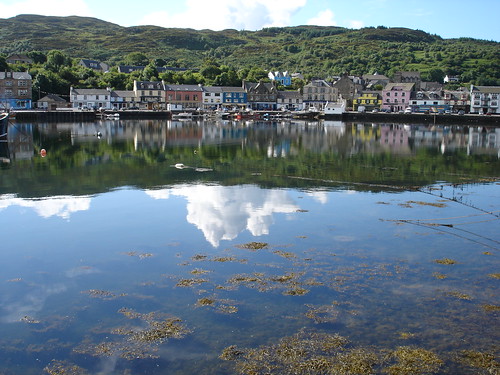 Campbeltown is much smaller than one would think it would be. We entered the town, really wanting a cup of coffee. But, parking spaces seemed to be of a premium, even though the streets were as wide as a city’s. Within a minute, we were out in the countryside again; neither of us had seen a café, or a place where to get a drink. We decided to press on to Southend; maybe we would have more luck there.
South of Campbeltown, the land flattens out, small holdings dot the land, and there to the west is the old Air Base at Machrihanish, once the worst posting in the UK, a desolate place to be sure. I noted that there was no pub in the village outside the gate.
Campbeltown is much smaller than one would think it would be. We entered the town, really wanting a cup of coffee. But, parking spaces seemed to be of a premium, even though the streets were as wide as a city’s. Within a minute, we were out in the countryside again; neither of us had seen a café, or a place where to get a drink. We decided to press on to Southend; maybe we would have more luck there.
South of Campbeltown, the land flattens out, small holdings dot the land, and there to the west is the old Air Base at Machrihanish, once the worst posting in the UK, a desolate place to be sure. I noted that there was no pub in the village outside the gate.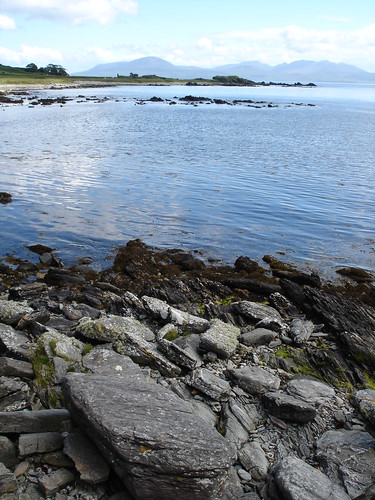 Southend is a very small village indeed; it has a shop, a single pump garage and a pub, along with a handful of houses. A mile further south is the beach, and the Irish Sea: just visible on the horizon is the coast of Northern Ireland.
Southend is a very small village indeed; it has a shop, a single pump garage and a pub, along with a handful of houses. A mile further south is the beach, and the Irish Sea: just visible on the horizon is the coast of Northern Ireland.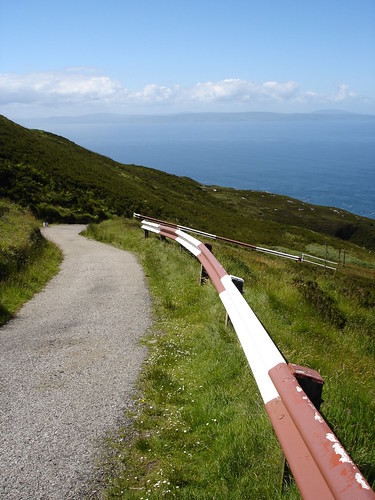 I stopped to take pictures, driving back into the town; I spied a sign to Southend Lighthouse. Not realizing Mum needed the bathroom, I headed off. It was only seven miles. But those seven miles were along single track country lane, across cattle grids, and up the steepest hills I had ever driven up and down, at one point, giving spectacular views of the bay and Southend in the distance. The road ended up at a desolate car park, perched on the edge of a cliff. The lighthouse was a mile down a 1 in 3 hill. I tried to go down, but my back at once indicated it was not happy. It’s a good job I only did a hundred yards or so, as it was a struggle back to the car. We headed off to Southend to find a bathroom, sheep scattering before us in all directions.
I stopped to take pictures, driving back into the town; I spied a sign to Southend Lighthouse. Not realizing Mum needed the bathroom, I headed off. It was only seven miles. But those seven miles were along single track country lane, across cattle grids, and up the steepest hills I had ever driven up and down, at one point, giving spectacular views of the bay and Southend in the distance. The road ended up at a desolate car park, perched on the edge of a cliff. The lighthouse was a mile down a 1 in 3 hill. I tried to go down, but my back at once indicated it was not happy. It’s a good job I only did a hundred yards or so, as it was a struggle back to the car. We headed off to Southend to find a bathroom, sheep scattering before us in all directions.The only place was the pub. It was a quiet but friendly place, and the only other customer at the bar said hello. Turned out his name was Donny, and was the local soak. He gladly accepted the offer of a pint, and asked us a thousand questions. The postmistress walked it, the pub is also the post office, and spoke to Donny, seems like he missed the bus for work that morning, and was in the pub until his £10 ran out. He could certainly put them away, as pint after pint was drunk.
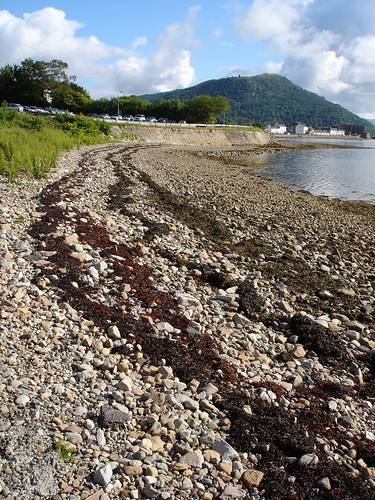 We took the A road back north: it ran along long golden beaches, small villages were scattered about. We stopped off in Lochgilphead for another bathroom break. It was another pub, stuck to the ceiling were about twenty football shirts of all teams: mainly Scottish of course. Once again, the locals were friendly; I say this because in some places, English are not welcome. I have had trouble in Wales and some parts of Scotland before.
Once back in Inveraray, I headed off into the town to the whiskey shop, as I heard they had a good selection. Indeed they did: I ended up with a 1969 Glen Grant, and a 16 year old Isle of Jura. After a days driving and retail therapy, what better way to relax than a pint at the George?
We took the A road back north: it ran along long golden beaches, small villages were scattered about. We stopped off in Lochgilphead for another bathroom break. It was another pub, stuck to the ceiling were about twenty football shirts of all teams: mainly Scottish of course. Once again, the locals were friendly; I say this because in some places, English are not welcome. I have had trouble in Wales and some parts of Scotland before.
Once back in Inveraray, I headed off into the town to the whiskey shop, as I heard they had a good selection. Indeed they did: I ended up with a 1969 Glen Grant, and a 16 year old Isle of Jura. After a days driving and retail therapy, what better way to relax than a pint at the George?That night, we did get what we ordered, and red meat with a chocolate sauce was interesting, though I doubt if I will be trying it again very soon.
The weather forecast for tomorrow is for showers, so the trip to Skye might not be on. Fingers crossed on that.
Tuesday July 5
Morning dawned with the sun pouring through the window, alas, it was not to last. We had the usual highland breakfast, without the black pudding. The choice for today was to go to:
1. Oban. If the weather was really rotten.
2. Isle of Skye
3. Or Loch Ness
The weather had turned cloudy, but was not too bad, and Mum really could not walk too far. Both Skye and loch Ness were long drives, but, we had time. We decided to see what the weather was like when the roads to either divided, some hours away.
We took the mountain road out of Inveraray, as we drove, the clouds rolled in. Soon, we descended into a wide valley, with a shallow, stone strewn river meandering across it. A stone castle sat on a small island where the river had been dammed. Just outside Oban, we turned off, and headed north across the Connell Ferry Bridge. Mum was already asleep, so missed the view from the narrow bridge. It was built as a railway bridge, but converted to road when the line closed. So, it is only wide enough for one car at a time. We came across a castle sitting on an island just off the coast, it was not marked, and I caught sight of it as we went through a village, found a place to pull over, and grabbed a shot.
We soon arrived in Fort William. We had visited here many years ago, and I remember it as just one street, with houses and hotels on both sides. Now, it is a sprawling town, with superstores and DIY stores all along the main road, now having lost any traces of quaintness. North of Fort William, we came to a greasy spoon caravan, sitting beside a loch. The turn off to Skye was only a few miles away, and we had yet to decide. I went and got a cup of coffee for us both. I asked the woman behind the counter, both and her 4 year old daughter said at the same time ‘Skye.’ So, Skye it was.
From Fort William to the Kyle of Lochalsh, it is 74 miles. And the road twists and turns, so it takes nearly two hours. We drove across mountains, moors, and through deep valleys. At each turn in the valley, one hoped the mountains were coming to an end. But, they went on. Although always heading downhill all the time. In due course, the valleys ended, and the coastline stretched out before us, a couple of miles away was the famous Eilean Donan Castle. As befitting such a scenic place, it was crowded with tourists, and to make matters worse, due to a sewer blockage, all toilets were closed. So enough time to grab a few pictures, and head off for working toilets. Not an easy task in the middle of the Highlands. The castle makes a great fuss about being a location for the Highlander films. Hmm, I just think it looks wonderful.
The road we were travelling on is known as the Road to the Isles, and the final town on the mainland if the Kyle of Lochalsh. It’s also the terminus of the rail line from Glasgow. So, it is reasonable to think that the town would be of some size. In fact, it’s a village, a fishing village really. The station has just one platform, and few trains came there now. Dominating the town and the sound between the mainland and the Isle of Skye beyond is the bridge to the isle. Crossing the bridge is now free, although until recently it cost more than two pounds. The ferry terminal lies now abandoned, as the bridge put it out of business. We were through Kyle before we realized, and so headed across the bridge to Skye. We followed the signs to the old ferry terminal on the isle. It is now a collection of huts and canteens, full of people on coach tours, not at all inviting. I had seen a sign to a county hotel as we turned off the main road, and so we headed back there. It was a Victorian country house, the bar set in a small downstairs room. But, it was cosy, and the food good, we had hot sandwiches, and lovely draught beer. They had a bottle of 51 year old Glen Grant at £8 a tot. But, as I was driving I did not think it a good idea. After eating, we drove further onto the Isle, eventually to the town of Broadford. It is dominated by a twin peaked mountain. We rally did not have time to stay and look round, as it was four hours to get back to the hotel, so reluctantly, we turned round and headed back to the mainland. As we went further south, the weather gradually brightened, making it a very pleasant trip indeed. When we arrived back at Fort William, Ben Nevis was just about cloud free. It was nearly half past six by the time we returned to the hotel, and we had travelled 312 miles, and Mum had slept through most of it. Still, I enjoyed myself.
Wednesday July 6 We had been worried about heading home, as it was the first day of the G8 summit, and much disruption was predicted in Scotland. In the end, we had more trouble in getting past Loch Lomond, as the Scottish Open was due to begin the next day, and fans were queuing to see the last day of practice. We were only held up 10 minutes of so, and in the traffic, we got wonderful views across the Loch, to the heather covered hills beyond, all purple and green in the bright sunshine.
The rest of the trip was fine, really. Traffic was light, weather fine, and we made good progress. Just south of Leeds, we heard that London was to host the 2012 Olympic Games. We cheered, and laughed at the cries of anguish of the French, as they were sure they were going to win. We stopped off for a meal at a roadside place, rather than have to cook when we got back. The last three hours of the trip, across the fens of Lincolnshire were a nightmare. Rain poured down, and an almost solid convoy of truck meant that we made slow time. So, it was a relief to get to Kings Lynn, and then Norwich as we neared home.

1 comment:
Fascinating - spent several hours reading and GSV-ing your Scotland Trip (in between work!)
Didn't realise you had done this exploring in Scotland and even over the bridge to Skye - I promise to do my best to make your next trip to Skye a little more memorable ;-)
Post a Comment